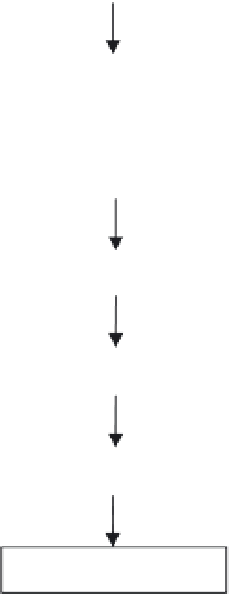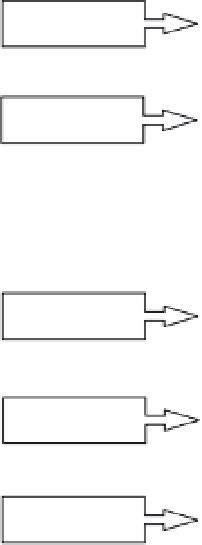Agriculture Reference
In-Depth Information
Dried peels
Supernatant:
Pigments, etc.
0.03 N NaCl
Washing
0.04 N NaCl
Hydrolysis
Hot water
Residue
Pectin extraction
Liquid extract
Permeate:
Flavonoids, carotenoids, etc.
Microfiltration
Retentate
Permeate:
Flavonoids, carotenoids, etc.
Water
Diafiltration
Retentate
Supernatant
Precipitation
95% ethanol
Precipitated gel
Ethanol washing
95% ethanol
Supernatant
Pectin gel
Freez drying
Water, ethanol
Pectin product
Figure 22.4.
Flowchart of pectin extraction from mandarin peels (source: Adapted from Cho et al., 2003).
content of pectin increased from 72.2% to 75.6%. The di-
afiltration process was also effective to remove flavonoids,
polyphenols, and carotenoids, which are impurities in
pectin products. Cho et al. (2003) recommended that the
cross-flow microfiltration system could be efficiently used
for concentration and purification of pectin.
Some other products are also available in market that can
be considered as citrus industry by-products like citrus peel
powder, seed oil, vinegar, and so on. The citrus seed oil is
of considerable importance as it falls under the category
of unconventional edible oil sources. However, the seed
oil production is limited in some species of easy peelers
like clementine and satsuma as they are seedless in na-
ture (although there may be some variations). Chemically,
orange oil contains about 90% d-limonene, with proven
health claims. Moreover, it is the ingredient of choice for
replacing the synthetic cleansing agents. Its smell is con-
sidered more pleasant than those of other cleaning agents
(Feger et al., 2003).
Innovative processing technologies
A number of innovative processing technologies have been
developed and are being used for fruit processing, for ex-
ample, high-pressure processing (Linton et al., 1999; Hsu
et al., 2008; Polydera et al., 2005), pulsed electric field
(Ayhan et al., 2002; Barbosa-Canovas et al., 1999; Min
and Zhang, 2003; Rivas et al., 2007), membrane filtration









Search WWH ::

Custom Search